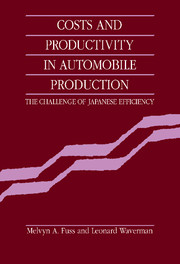Book contents
- Frontmatter
- Contents
- Preface
- Chapter 1 Introduction
- Chapter 2 International differences in output, productivity, and wages in the automobile industry: the 1950s to the mid-1980s
- Chapter 3 The cost-function approach to the analysis of cost and total factor productivity differences
- Chapter 4 Data base sources and method of construction
- Chapter 5 Empirical results: estimation of the cost function
- Chapter 6 Productivity growth in the automobile industry, 1970–1984: a comparison of the United States, Japan, Germany, and Canada
- Chapter 7 International comparisons of automobile industry cost and productivity levels: Japan, Germany, and the United States
- Chapter 8 International comparisons of automobile industry cost and productivity levels: Canadian with U.S., Japanese, and German production
- Chapter 9 Summary and conclusions
- References
- Index
Chapter 6 - Productivity growth in the automobile industry, 1970–1984: a comparison of the United States, Japan, Germany, and Canada
Published online by Cambridge University Press: 16 October 2009
- Frontmatter
- Contents
- Preface
- Chapter 1 Introduction
- Chapter 2 International differences in output, productivity, and wages in the automobile industry: the 1950s to the mid-1980s
- Chapter 3 The cost-function approach to the analysis of cost and total factor productivity differences
- Chapter 4 Data base sources and method of construction
- Chapter 5 Empirical results: estimation of the cost function
- Chapter 6 Productivity growth in the automobile industry, 1970–1984: a comparison of the United States, Japan, Germany, and Canada
- Chapter 7 International comparisons of automobile industry cost and productivity levels: Japan, Germany, and the United States
- Chapter 8 International comparisons of automobile industry cost and productivity levels: Canadian with U.S., Japanese, and German production
- Chapter 9 Summary and conclusions
- References
- Index
Summary
Introduction
In this chapter we calculate and analyze the automobile industry's cost and productivity experience during the 1970s and early 1980s in the United States, Japan, Germany, and Canada. Using our econometric cost function methodology, we are able to isolate the major source of shortrun disequilibrium in this industry – variations in capacity utilization – and analyze its effect on cost and total factor productivity (TFP) growth. The importance of analyzing variations in capacity utilization is confirmed by the fact that failure to correct for this source of productivity change over the period 1970–84 would have led to a 20% overestimate of long-run TFP growth in Canada and a 22% overestimate for the United States.
Even after correcting for capacity utilization differences, the Japanese productivity “miracle” is evident from our results (see Table 6.5). During the 1970s, total factor productivity in the Japanese automobile industry grew at an average rate of 3.9% per annum. By way of contrast, the Canadian and U.S. automobile industries both experienced average perannum TFP growth rates of only 1.2%, less than one-third of the Japanese rate. The TFP growth of the German auto sector in the 1970s was slightly more than that achieved in North America, averaging 1.4% per annum, a growth rate far below that achieved in Japan.
- Type
- Chapter
- Information
- Costs and Productivity in Automobile ProductionThe Challenge of Japanese Efficiency, pp. 131 - 141Publisher: Cambridge University PressPrint publication year: 1992



